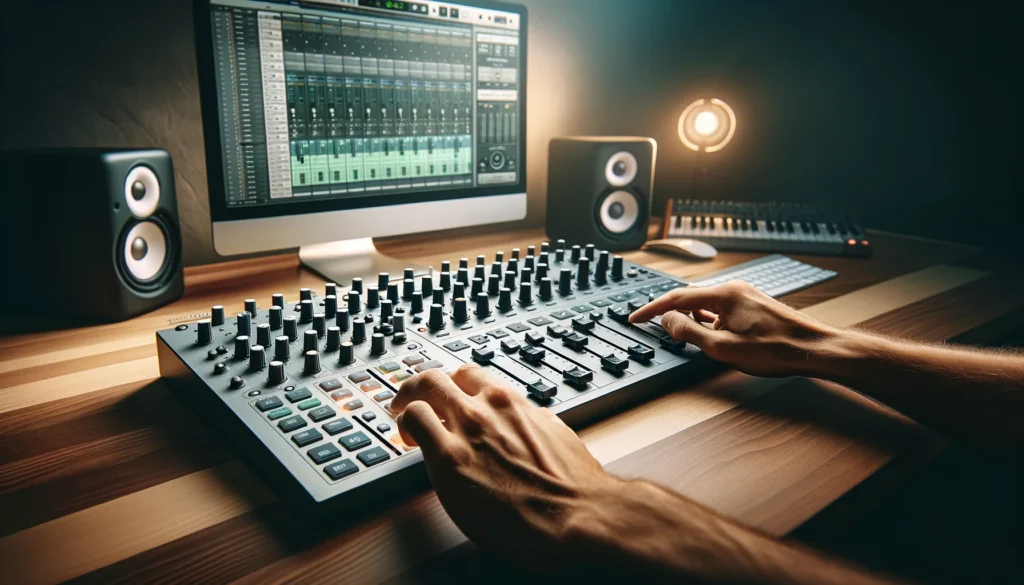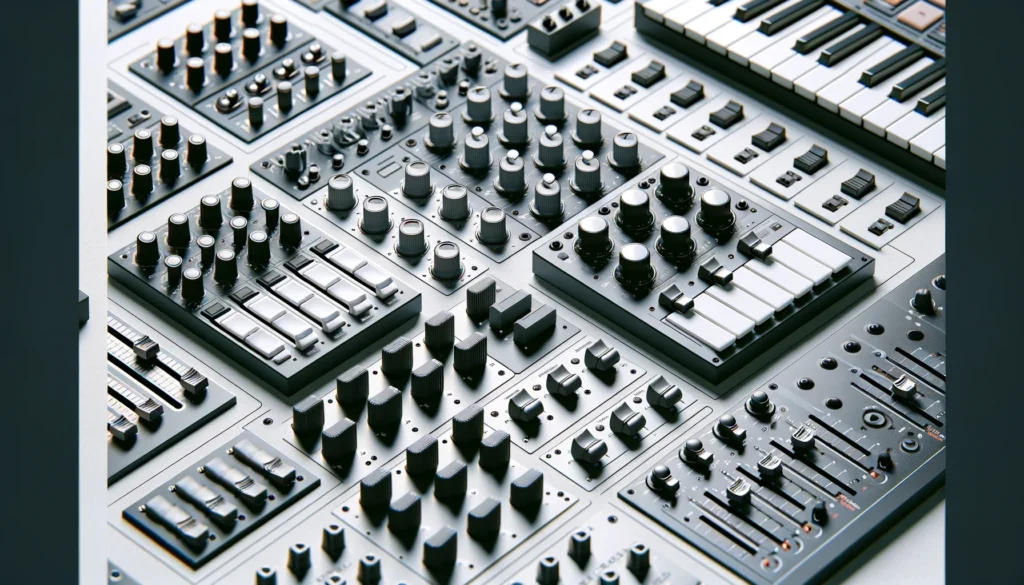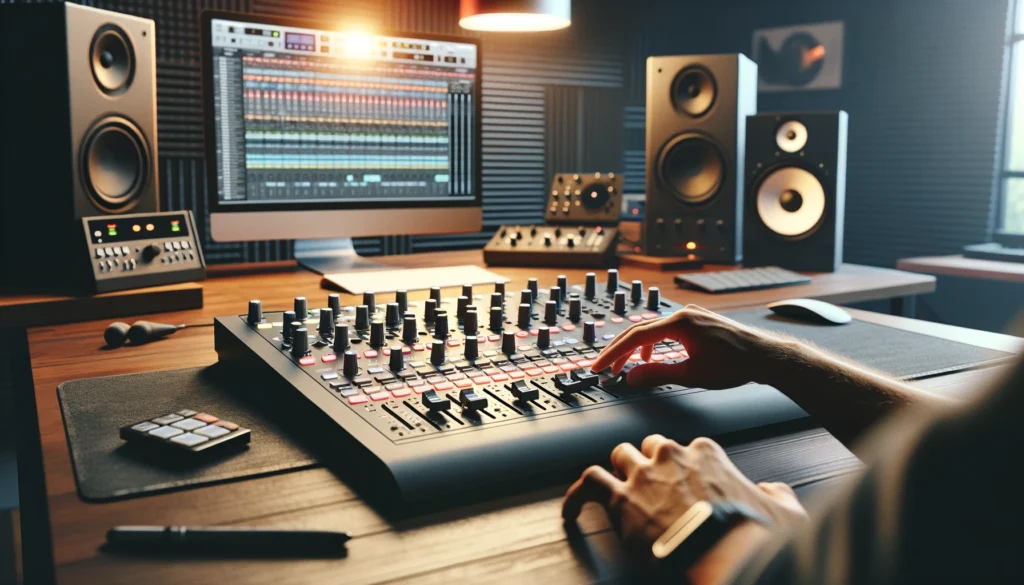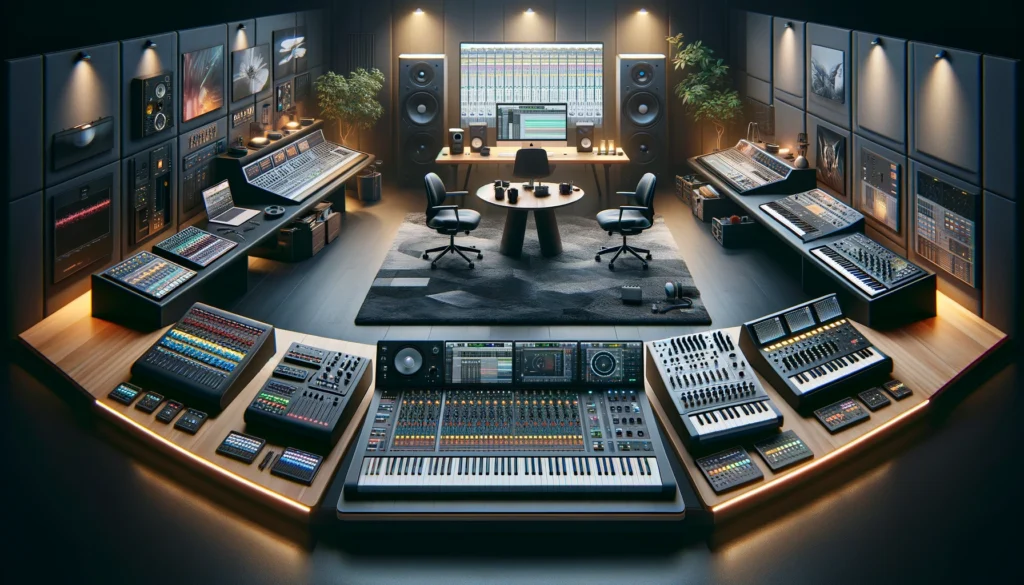Struggling with the limitations of mouse and keyboard control over your music production software?
MIDI control surfaces enable tactile, hands-on hardware control to transform music mixing and editing workflows.
Let’s explore what exactly a MIDI control surface is and the benefits it provides.
What is a MIDI Control Surface?

A MIDI control surface is a hardware device that connects to music production software and enables real-time, tactile control of parameters using physical buttons, faders and knobs instead of only a mouse and keyboard.
This facilitates faster, more creative workflows and a better user experience.
We’ll explore MIDI control surfaces and their capabilities in more detail below.
What is a MIDI Control Surface?

A MIDI (Musical Instrument Digital Interface) control surface is defined as a hardware controller which enables hands-on control of various parameters in MIDI music production software and hardware.
The control surface connects to a Digital Audio Workstation (DAW) or hardware synthesizer via MIDI or USB connectivity.
This allows for real-time tactile control over mixing console functions such as faders, pans, mutes and more.
Additionally, transport controls like play, record and stop can be manipulated as well as software instruments, synth parameters and effects plugin parameters.
Overall, a MIDI control surface provides a more intuitive and hands-on way to control many aspects of music production rather than only using a computer mouse and keyboard.
The key components of a MIDI control surface consist of faders to control channel levels, synth parameters and more.
Pots and encoders are included for functions like panning, effects sends and plugin parameters.
Transport controls will enable easy access to play, stop and record functions.
Automation controls may also be featured to record and edit parameter changes.
Mute and solo buttons per channel allow quick audio switching along with LCD or LED displays for visual feedback.
Assignable buttons can be programmed to map parameters for customized workflows.
Quality control surfaces also feature tight integration with DAW platforms and plugins for efficient operation.
There are several benefits to using a MIDI control surface for music production.
The tactile hands-on approach enables faster workflows for mixing, editing and sound design.
The physical controls facilitate spontaneity and experimentation in ways that mouse and keyboard interaction struggle to match.
Control surfaces can be customized to suit specialized workflows for increased productivity.
Ergonomically, the dedicated tactile controls significantly reduce physical strain compared to extensive use of a computer mouse and keyboard.
Key Components of a Control Surface

There are several key components that make up the design of a MIDI control surface.
One of the most important elements is faders, which enable hands-on control of channel levels, synth parameters and more.
High resolution motorized faders maintain precise calibrated levels and settings between the surface controls and interfaced software.
Another vital component consists of pots and encoders, which manage functions like track panning, effects sends to auxiliary channels, as well as manipulating plugin and effects parameters.
Transport controls will allow easy access to essential playback, recording and positioning commands.
Large tactile buttons for play, stop and record enable foot-free operation.
Some surfaces include jog wheels and scrubbing functions for DAWs missing dedicated controllers.
Automation controls give the ability to record and edit parameter changes as well as write, latch and trim automation passes.
Per channel components like mute, solo and selector buttons increase mixing efficiency and speed of access.
Multiple cue mixes can be handled with dedicated control per channel.
LCD and LED displays range from simple indicators to full screens with metering, dependent on the surface complexity and price.
Assignable buttons allow customized mapping of functions to suit specialized workflows.
More advanced integration with host DAWs and software instruments enables bidirectional communication and automatic mapping of parameters.
Benefits of Using a Control Surface

One of the major benefits that a dedicated MIDI control surface provides over a simple mouse and computer keyboard setup is the tactile hands-on approach to critical music production tasks.
Manipulating physical faders, buttons and knobs facilitates faster workflows as well as tighter integration to the creative process.
The velocity sensitive controls encourage spontaneity and experimentation with both levels and effects that is harder to achieve with the precision and limitations of mouse control.
This leads to workflows with greater artistic flexibility and tools immediately at hand to develop ideas quickly.
Control surfaces enable customized programming and layouts to suit specialized mixing, editing and sound design needs.
Frequently used functions can be mapped to buttons within easy reach which vastly improves productivity compared to hunting through complex software menus and windows.
The dedicated physical controls are also highly ergonomic and avoid extended use injuries associated with mouse and keyboard operation.
Positioning can be adjusted to suit working posture.
Additional integration options with host platforms and instruments enables advanced automatic mapping of parameters for bi-directional control synchronized between hardware and software interfaces.
There is also a range of control surface sizes and complexities to match needs and budgets.
Compact affordable designs provide access to critical mixing and transport functions while maximizing desk space.
Full scale large format consoles mimic professional studio mixing desks for sophisticated surround sound production tasks.
Modular designs allow custom selections of channel strips and master section options.
Integration focussed surfaces provide tight DAW and instrument control for certain platforms.
Top tier keyboard synthesizer workstations feature seamlessly integrated control surfaces with motorized faders and thousands of parameters at the fingertips.
Careful selection combined with the benefits above can take music production capabilities to the next level.
Types of Control Surfaces

There are several categories and sizes of MIDI control surfaces available to match needs and budgets.
Compact and portable designs offer slimline mixing channels in a small footprint perfect for music producers short on space.
These provide access to the most critical channel strip functions like faders, pans, mutes and solos without breaking the bank.
Models with 8 or 16 channel strips balanced with master section transport and editing controls make an excellent entry point for adding tactile control.
At the top end, large format consoles emulate full sized professional mixing desks for advanced surround sound mixing and production.
Channel counts stretch up to 64 simultaneous tracks with motorized faders, mute/solo buttons, insert points and integrated monitoring controls.
Multiple bank switching enables hundreds of tracks to remain at the fingertips.
The master section mimics high end studio gear with control room options, talkback and monitor selection.
These advanced surfaces enable complex mixing, editing and automation with touch sensitive controls operated in real-time.
Modular control surfaces allow customizable selections of channel strips and master sections that suit precise needs.
Channel strips are available in blocks of 8 or 16 faders for example, which can be combined with meter bridges, master controls and editing modules.
Flexible mounting enables ergonomic configurations for either sitting or standing postures.
Setup is more complex but enables building advanced control rooms cost effectively and only investing in functional modules actually required.
Keyboard synthesizer workstations offer deep integration with their onboard synth engines and effects via seamlessly integrated control surfaces.
The tactile manipulation of virtual instrument parameters makes them extremely versatile for electronic music production.
Huge color LCD displays with motorized faders transform the keyboard into a comprehensive mixing desk and editing bay.
Native Map technology enables NKS compatibility for tight DAW and plugin integration.
Advanced keyboard workstations set the standard for tactile electronic music production capabilities.
Finally, affordability and portability trade off against complexity with compact DAW specific control surfaces.
These often include templating and LCD displays enabling automatic parameter mapping with host platforms like Ableton Live for streamlined operation.
Control can be programmed deeper than generalized surfaces but often at the cost of customization.
Overall they deliver seamless integration balanced against flexibility.
Consider which trade-offs best suit music production needs when selecting a control surface.
Conclusion
In summary, a MIDI control surface is designed to give music producers and mix engineers greater tactile control over their Digital Audio Workstation environment.
The hands-on experience enables faster workflows, tighter software integration and unlimited creative flexibility compared to more traditional mouse and keyboard operation.
Key components consist of faders, encoders, transport controls, displays and deeply integrated automation functions.
There is a diverse range of solutions balancing size, complexity and pricing suitable for beginners through to professional studios.
Selecting the right control surface can truly transform music mixing and production capabilities to the next level.
